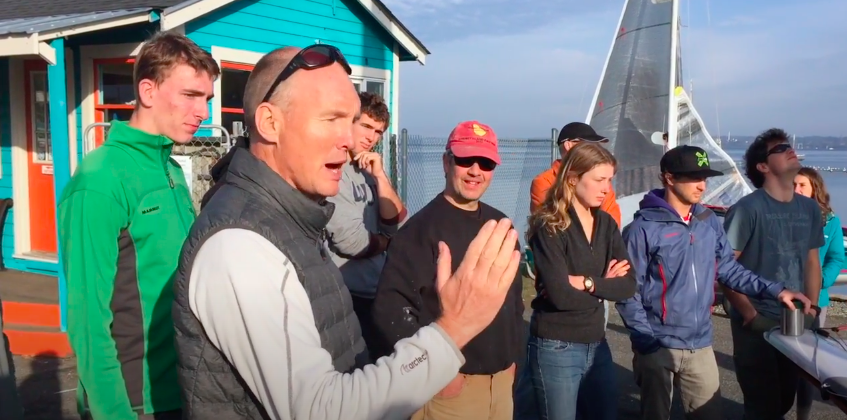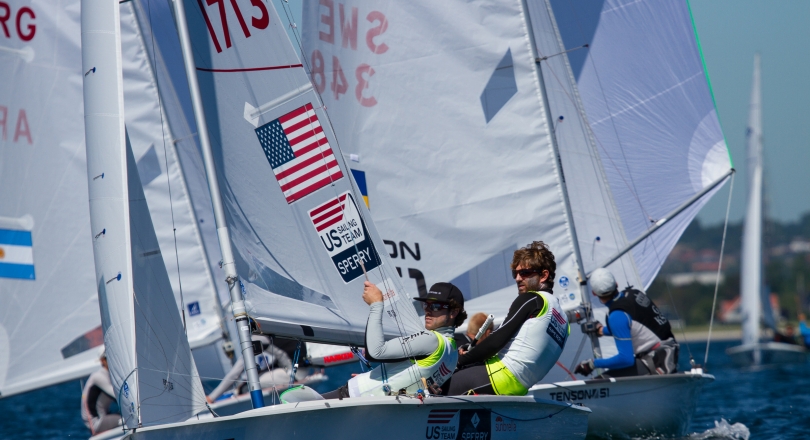2016 Gold medalist and North Sails expert Sîme Fantela answers your questions about sailing the 470...
Who sails the 470?
The 470 has been an Olympic double-handed class since 1976, with separate men’s and women’s divisions since 1988. Today most sailors are full-time Olympic hopefuls, and because the boat is so technically and physically challenging many teams stay together for several four-year training cycles. The boat can be sailed by a range of weights and heights, though most helms are shorter and smaller than their crews to maximize righting moment. Men’s helms range from 55-65kg and crews from 65-80kg, aiming for a combined weight between 130-140kg. Women’s teams are usually bit smaller, targeting between 120-130kg of combined weight.

What does it take to be successful in the 470?
You need to be passionate about it. You need to be focused on the training process, you really need to enjoy the boat and sailing and the hard work that comes with it. Competing successfully is not only about sailing and tactic; it’s a lot about the technical side of the class. To be successful, you need to understand how the boat works, how the foils work, how the mast and the sails work, and how all these things work together. It’s very important to feel all these things, so you can tune the boat well in different wind ranges.
Who does what on the boat?
Upwind, the helm is steering and controlling the mainsheet, cunningham, and vang, as well as adjusting the centerboard up and down. The crew is responsible for trimming the jib, and obviously for hiking and the balance. Most of the boat handling and the kinetics are the crew’s job.
Downwind, the helm hoists the spinnaker and trims it temporarily while the crew is setting or dousing the pole. The crew trims the spinnaker and balances the boat both fore and aft and side to side.
470 Tuning
What are the keys to rig set-up?
The most important aspect is to understand what suits your team. If you are a standard size (small-light helm and tall-heavy crew), follow the North Sails Tuning Guide. If you are not a standard size, you will have to work at finding the right mast stiffness, spreader length, mast step position, centerboard pivot position, centerboard stiffness, and model of sails. Then you can start to fine tune the boat and rig, depending on feedback from sailing against other teams.
What are the keys to rig tuning?
The key adjustment is rig tension. There are two different setups: the “standard” has less purchase, and the “soft” is easier to play while racing. You can choose which kind of purchase you want when ordering a boat. Many experienced teams choose the soft purchase, so it’s not just how much experience you have; everyone has their own tuning styles and ways. There are some very useful photos of this and other systems on the McKay Boats website.
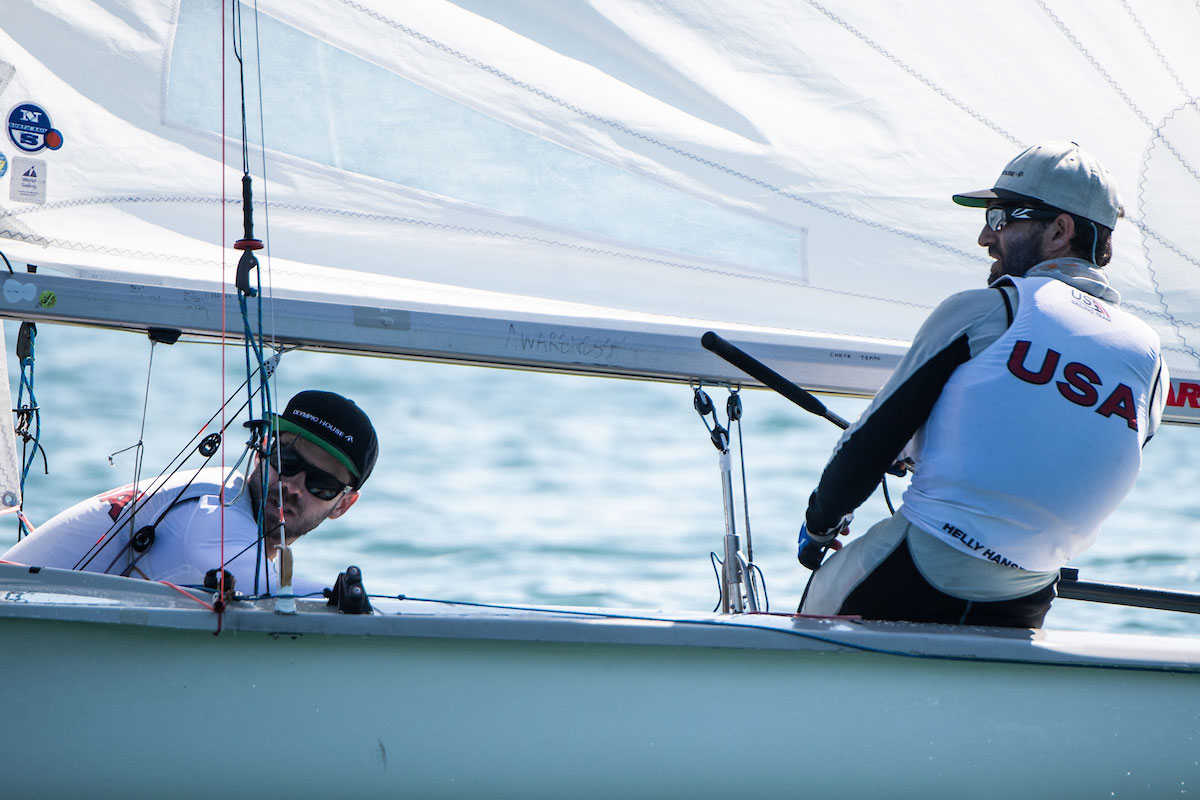
Upwind Sailing
Where does each person sit on a 470 in light air?
Sit as far forward as possible. If the crew is not on trapeze, then they sit on the deck and try to press the boat flat by leaning out. As the breeze comes up, they move onto the trapeze, first with knees bent and then with knees straight. Once the crew is fully extended, the helm starts to hike.
What are the key changes in different conditions?
It is very important to understand when you go from underpowered to overpowered. Sail trim and crew position are important adjustments until you are fully hiking. Then you start depowering the boat with the different controls.
What do you focus on when trimming the 470 main?
Trimming the main, the focus is the leech and twist. The perfect amount of twist depends on the sea state. If it’s flat water, I like a tight leech, but I don’t ever close it completely. In waves, more twist makes it easier to steer.
What do you focus on when trimming the 470 jib?
You need a different setup depending on whether it’s flat water, chop, or swell: more twist in the waves, and less twist for flat water. I play with the lead in gusts and lulls; you can move it fore and aft, and also in and out (there are 5 positions, and 1 is max inboard while 5 is max out). In light wind, you want it inboard and forward; for strong wind, ease it out and/or move it aft. This helps to open or close the slot between main and jib.
What are the key adjustments to make when wind and sea state increase?
Key adjustments are centerboard height, jib lead, vang, outhaul, cunningham, and the height of the jib. Let’s say the wind is starting to build. To depower the main, pull on cunningham, outhaul, and vang. For the jib, lower the height, pull on jib cunningham, and move the jib lead aft/out. If you are still overpowered, raise the centerboard.
Any other advice about gear changing in a 470?
You need a lot of hours in the boat to understand how it feels in different conditions and what the boat wants to be quick. You need to have all these tools in your hands and to adjust when conditions change, or when you want to change the mode of sailing. If you want to go quick and low, or slow and high, you need to be able to do it—and this doesn’t come easily.
What’s the typical conversation between 470 helm and crew?
It’s mostly about who is doing what on the boat. On our boat, as helm I was doing the tactics and my crew was focused on speed, but sometimes when the conditions changed we would swap roles; I would focus on speed and the crew would take over tactics. The other loop is talking about boat speed: how do we feel, should we change something? You always compare yourself with the boats around you about the speed and mode of sailing.
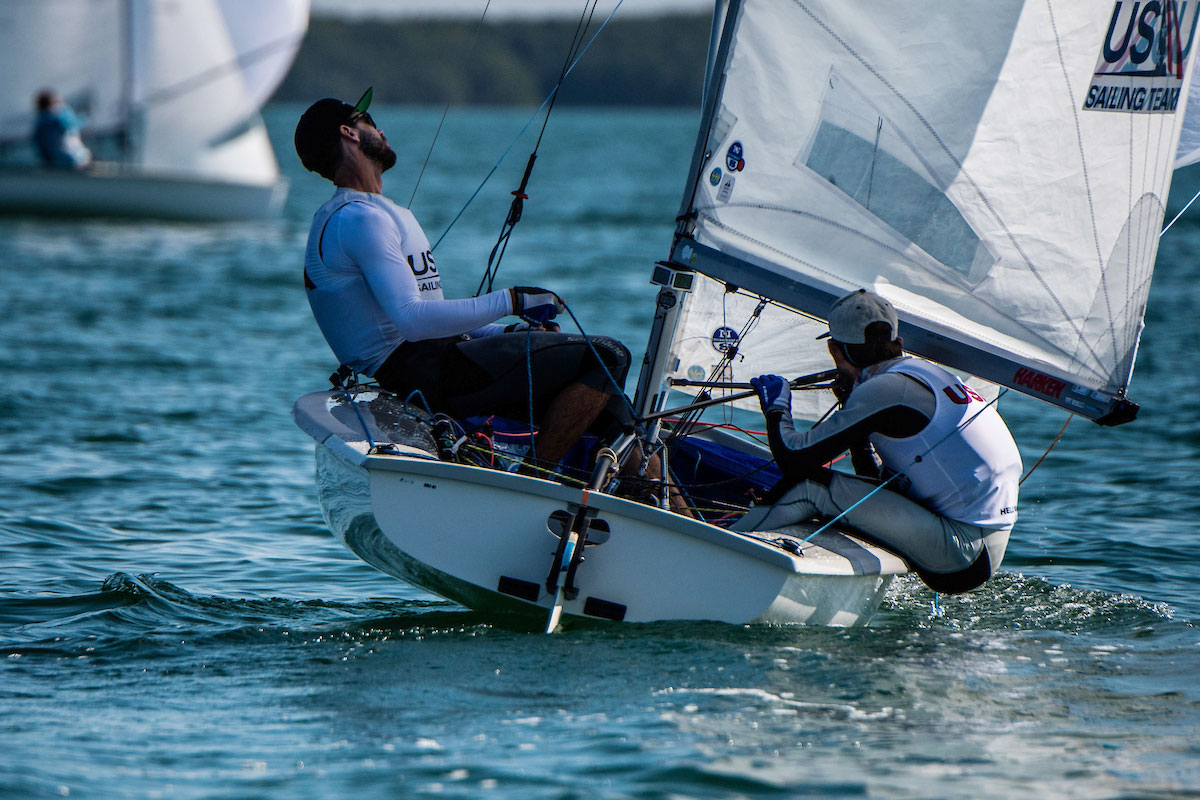
Downwind Sailing
What 470 spinnaker would you recommend?
North Sails has three different models: V2, A2, and V3. The V2 is flatter on the top and easier to steer to. The A2 has the biggest projected area, it’s the most powerful one. The V3 is a bit fuller on top. So each team should decide which kite to use depending on their style of sailing—if they want to sail low, or want to play with the waves and sail high. For more details, view the North Sails 470 Inventory.
Where does each person sit in a 470 downwind?
Downwind, the helm sits on the leeward side and the crew sits to windward to trim the spinnaker. In lighter breezes the crew sits as far forward as possible, close to the shroud; one trick in super-light winds is to sit in front of the shrouds, just at the splash rail, to lift the stern out of the water and minimize the wake.
As the breeze comes up, the crew moves aft—sometimes even behind the traveler bar. In really extreme big breeze and waves, both the helm and crew will sit all the way aft, close to the rudder, to put the bow up and surf as much as possible.
What are the key adjustments to make sailing downwind?
It’s important to feel the sea state and decide how high to sail compared to the waves; you don’t want to stop in the waves, you want the boat to plane. You have to find your own way of sailing depending on the fleet, the waves, and the wind. The fastest teams spend a lot of time sailing the boat downwind in different wind conditions, because in this class the biggest gains are made downwind.
Downwind, you want the main as deep as possible in almost all conditions. Ease outhaul and cunningham, and adjust the vang so that the leech is open for a nice flow around the main. Having the top batten parallel with the boom is good as a starting point, and then you fine tune from there.
Another good rule is to keep the spinnaker pole parallel with the boom as it goes in and out. If you let out the boom, move the spinnaker pole aft. If you start to sail higher angles and pull in the boom, let the pole forward. These rules work in most conditions.
What’s the most important thing about 470 trimming downwind in light air?
Keep the slots open between kite, jib, and main. If it’s really light, so you can’t pull back the spinnaker pole, you’ll need to trim in the main.
What’s the most important thing about 470 trimming downwind in heavy air?
Let the boom out to the shroud and raise the pole to close the leech of the kite, keeping as much power as you can handle. Then focus on crew work: working the waves, balancing the boat. The higher the centerboard, the faster you will go, so you want to lift it as much as possible—but that depends how much stability you need. As a beginner, start with the centerboard down more, to have a more stable boat. As you get better controlling stability with bodies and sails, the centerboard can go higher and you’ll go faster.
What is a typical conversation downwind?
Here are the two questions:
- What mode do we want to achieve (high and fast, or low and slow)?
- Is the Oscar flag up so we are allowed to pump?
If we are pumping, usually the helm counts down the timing: three, two, one, pump. We try to move our bodies together and pump the main and spinnaker together. The most important thing downwind is to catch waves while being synchronized as a crew.
Any special considerations to sail the 470 well downwind?
You have to listen to what the boat tells you and how it feels, then listen again to how it reacts to a change of mode. One mode might suit your team best, but you still have to master the others to be quick in different tactical situations.
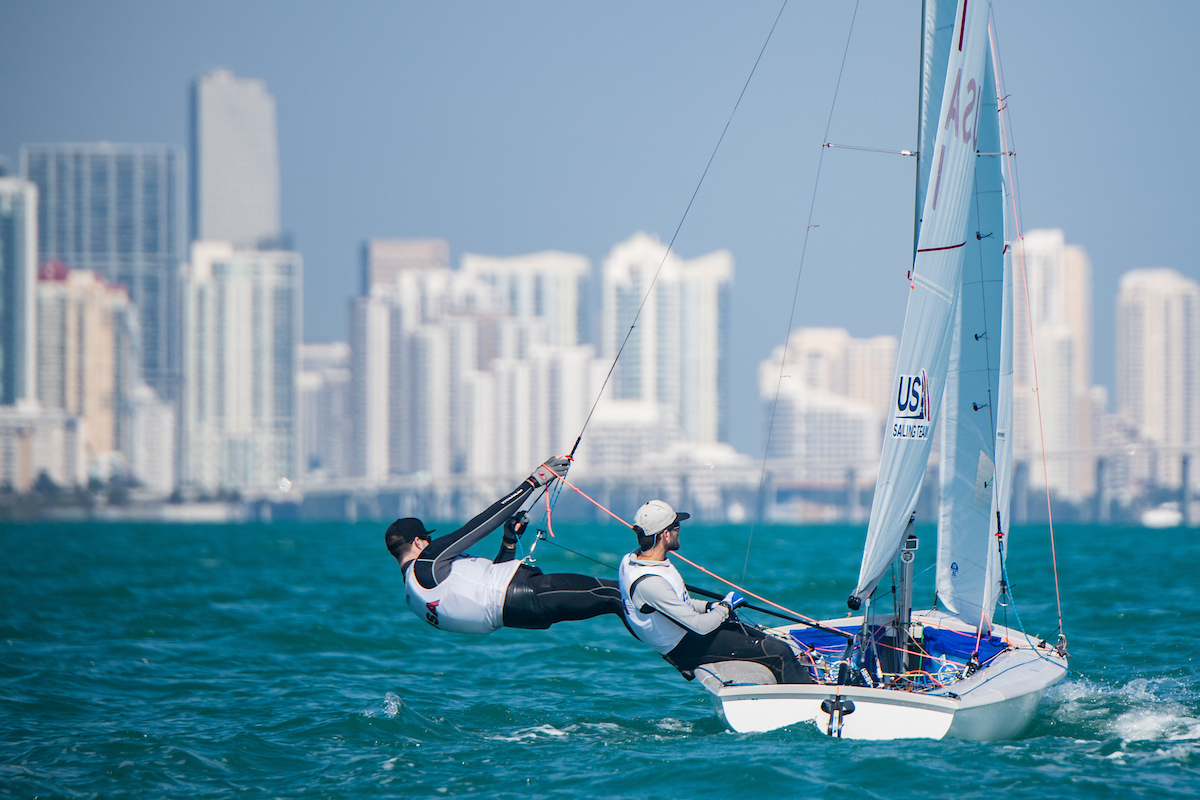
Boat Handling
Top three tips to starting a 470 well?
- Try to keep the flow on the rudder and centerboard as long as you can. Once you lose that, it can take some time to attach again.
- Always fight for space down to leeward. If you don’t have enough, you’re not going to survive the first 100 meters.
- Identify the last possible moment for a double tack. And whether you double-tack or not, know the right time for good acceleration and the right exit angle.
Any tips for 470 downspeed boat handling?
The most important thing is to keep flow on the rudder and centerboard. If you are going slow, keep the main in. If you have to kill speed, luff the jib but try to keep flow in the main as long as possible.
Work bodies and sails together. It is really crucial to be synchronized: at the start, both helm and crew go to leeward, prepare for the acceleration, and then squash the boat flat and trim in main and jib at the same time. Sheeting and flattening the boat together is the only hope for a good start.
What is the most common mistake when tacking a 470?
Not synchronizing helm and crew with rolling the boat into the tack, not flattening at the same time on the exit, and not maximizing the roll.
What does each person do in a tack?
The helm sheets the main in tight as you come head to wind and then eases it out again. Once on the new tack, trim in as the boat accelerates. The crew needs to balance the boat and provide the right amount of heel, while at the same time trying to be precise with jib trim. It’s quite a tough job for the crew to do a really nice tack.
Key tip for good light-air tacks in a 470?
Maximize the roll of the boat by putting the leeward shroud almost into the water before the tack. When you roll to windward, put that side into the water, and then squash the boat flat on the new tack. All this must be combined with simultaneous trimming of jib and main. The most important thing tacking in light winds is to maximize the power that you have in the boat and what you create with the tack.
Key tip for good heavy-air tacks?
Don’t roll the boat; keep it flat both entering and exiting the tack.
Key tip for good light-air jibes?
In light air, try to turn with minimum rudder and work on the kinetics for roll jibes. The biggest mistake is not to roll the boat.
Key tip for good heavy-air jibes?
Keep the spinnaker full through the jibe, and keep the boat flat; if you roll the boat at all, you risk a capsize.
What’s the best way to set a 470 spinnaker? Who does what?
It’s really important to have a solid routine for spinnaker sets. The fastest set we found was for the crew to:
- Come in off the trapeze wire.
- Take the spinnaker tack out of the spinnaker bag with one hand, while pulling on the windward barber-hauler/twing with the other hand.
- Hook the pole to the sheet, topping lift, and mast – Jaws up!
As the crew sets the pole, the helm stands up and hoists, then grabs a sheet in each hand. (In medium and strong breeze, steer with the rudder between your legs.) You can fill the spinnaker before the crew sets the pole.
It’s important to have the leeward sheet marked at the right amount of trim, so when the spinnaker goes up, it fills automatically before the crew or helm takes it from the cleat.
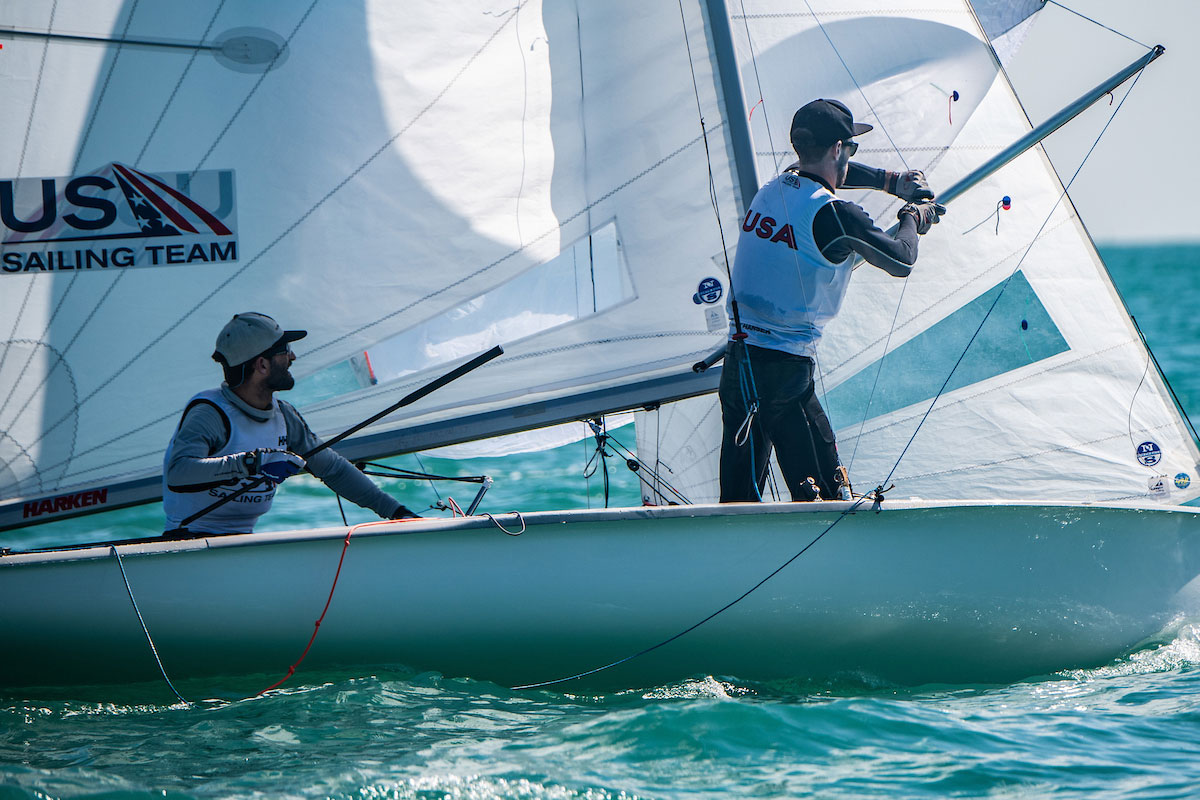
What’s the key to a good 470 spinnaker takedown?
The best spinnaker takedown is when the helm stands up and trims the spinnaker with a sheet in each hand, so when the pole comes down the spinnaker is still flying. At the last possible moment, the crew grabs the tack and drops it into the sock. The goal is to keep the spinnaker flying as long as possible.
Personal Tip: We always have a windward takedown, because we have a storage bag on each side of the boat.
Doing a 720 penalty turn is slow. What are the keys to minimizing the pain?
Try and synchronize the roll of the boat while minimizing the steering. When crew and helm act as one body, that’s the best. If you can, do the spins almost without the rudder, and start with a tack. On the bearaway, have a nice windward heel into the jibe, again minimizing the steering by working the bodies together. Always tack first, even from downwind.
How easily does the 470 broach or capsize?
Not that easily. Downwind, or reaching in strong breeze, you might broach if you lose control of the rudder because it ventilates, which happens quite often. Or in strong breeze if you lose your balance, or roll the boat too much in the jibe, you definitely will capsize.
How do you recover from a 470 capsize?
Try not to let the boat fully capsize, unhook the spinnaker pole, and right the boat.
What are the most common boat helming mistakes made in the 470 class?
When you are not in control of the boat. Control the feel of the boat upwind and downwind, and you’re going to do well.
Any suggestions for drills to improve 470 boat handling?
Sailing a figure eight in any wind will take you far. Circling around one mark, even in 20, 25 knots, is a really good drill to be strong in boat handling. Or set up a short race course that gives you just enough room to put up the kite, do one jibe, take it down, and go back upwind. That will improve your boat handling in all conditions.
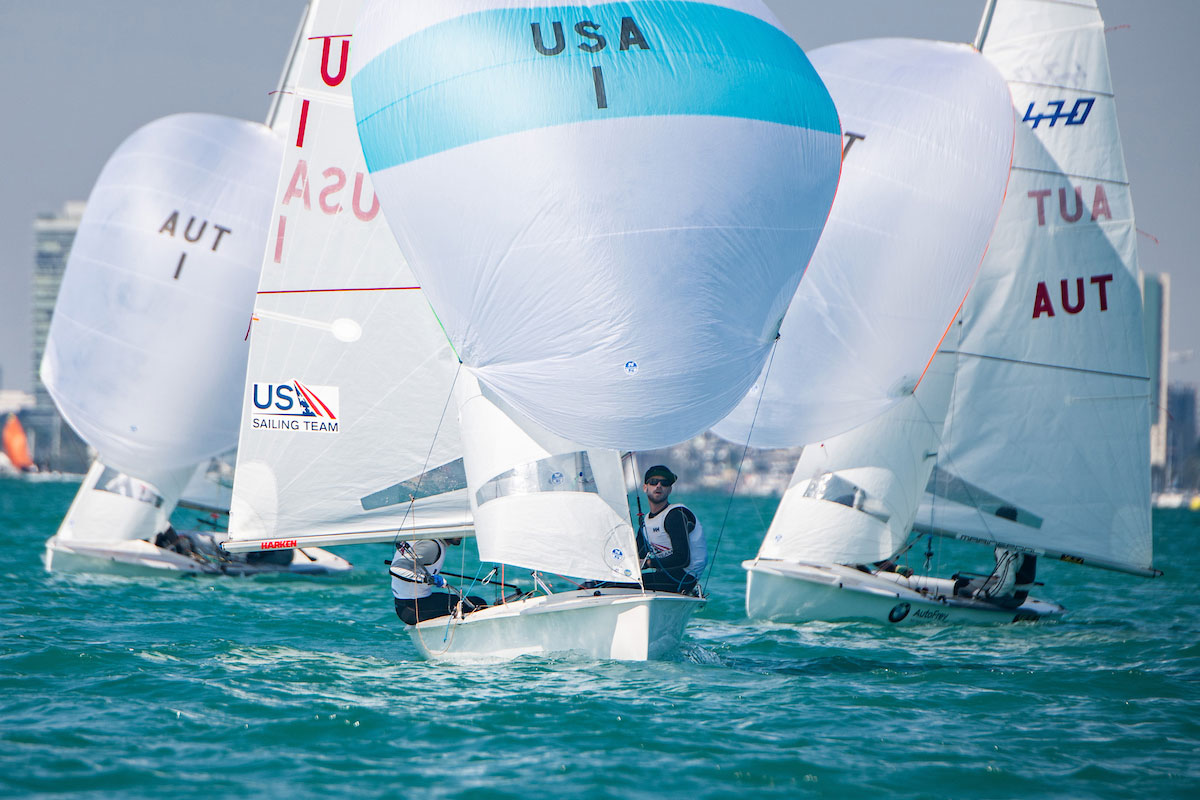

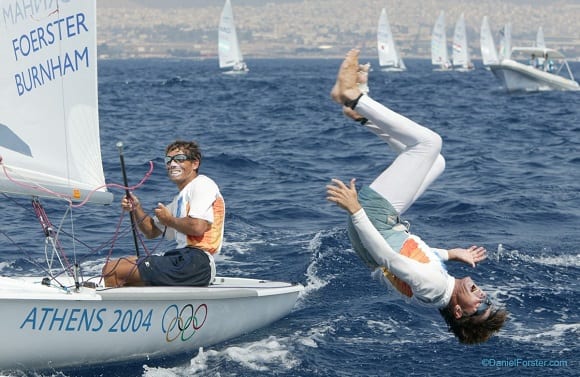

 The Race Ahead program began in 2008. The project was initially started by Roger Hudson and his father in order for them to build a foundation that consisted of a support system for the top young and talented sailors in South Africa.
The Race Ahead program began in 2008. The project was initially started by Roger Hudson and his father in order for them to build a foundation that consisted of a support system for the top young and talented sailors in South Africa. 